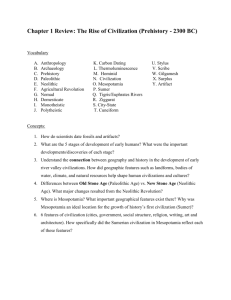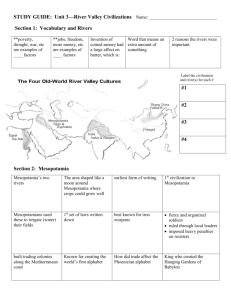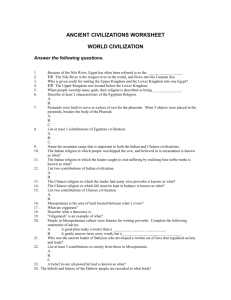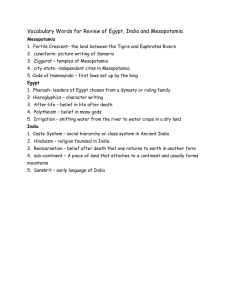Western civilization i
advertisement
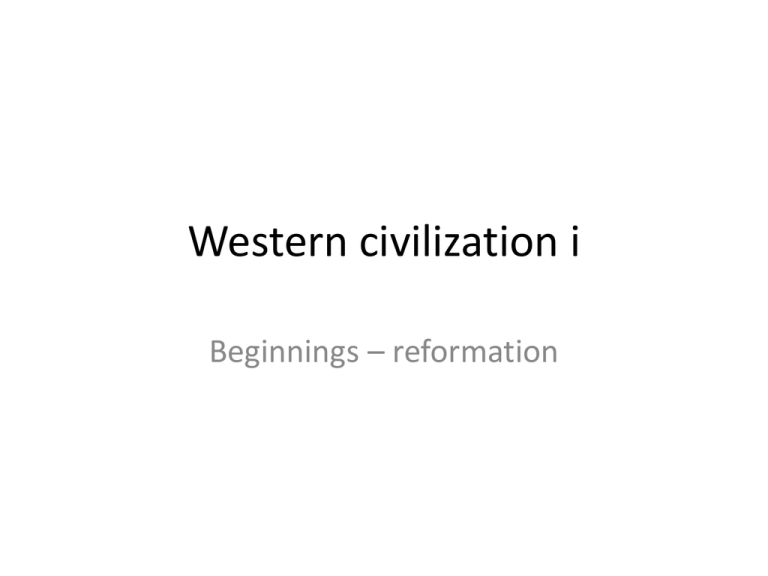
Western civilization i Beginnings – reformation August 30: Beginnings • Beginnings • Mesopotamia • Egypt Beginnings • • • • • History of civilization: how to date? Definition of “text” Hunter/gatherer vs. producer/settler Definition of “culture” Definition of “civilization” Beginnings • History of civilization: how to date? – How far back “history” takes us – What is datable • • • • Definition of “text” Hunter/gatherer vs. producer/settler Definition of “culture” Definition of “civilization” Beginnings • History of civilization: how to date? – How far back “history” takes us (and other disciplines) – What is datable • Definition of “text” – Artifacts that are left behind (natural, artificial) – Especially the written word • Hunter/gatherer vs. producer/settler • Definition of “culture” • Definition of “civilization” Beginnings • History of civilization: how to date? – How far back “history” takes us (and other disciplines) – What is datable • Definition of “text” – Artifacts that are left behind (natural, artificial) – Especially the written word • Hunter/gatherer vs. producer/settler • Definition of “culture” – All the ways humans adjust to their environment, organize experiences, and hand over traditions • Definition of “civilization” Beginnings • History of civilization: how to date? – How far back “history” takes us (and other disciplines) – What is datable • Definition of “text” – Artifacts that are left behind (natural, artificial) – Especially the written word • Hunter/gatherer vs. producer/settler • Definition of “culture” – All the ways humans adjust to their environment, organize experiences, and hand over traditions • Definition of “civilization” – Urban culture, with distinct characteristics Beginnings • Various ages: paleolithic, neolithic, bronze, iron (know why they are distinguished and relative dating) • The marks of civilization: agriculture leading to cities, metals, and WRITING – Civilization exhibits social hierarchy – Civilization produces skilled arts and crafts Mesopotamia Mesopotamia • c. 3500-3000bc: dvlpmt of Sumerian cities (esp. Uruk) • c. 2800-2370bc: Early Dynastic period of Sumerian city-states* • c. 2370-2340bc: Sargon est. Akkadian dynasty & empire (* the setting of Gilgamesh) Mesopotamia • c. 2125-2027bc: 3rd Dynasty of Ur** • c. 2000-1800bc: Amorites in Mesopotamia • c. 1792-1750bc: Hammurabi reigns • c. 1500bc: Est. of Kassite Dynasty at Babylon (** the earliest oral and written record of Gilgamesh) Mesopotamia: 4th to mid-3rd millennium (3500-2340bc) • Uruk and the other Sumerian city-states were redistributive economies – Central authority controls resources and redistributes – King and / or temple priests • Need for land leads to expansion and war; military leaders eventually amass power and become kings – Religious tradition confirms right to rule • City-states never united, but a common culture – Diplomacy and trade – Common pantheon – But different languages (Sumerian, Akkadian) Mesopotamia: Sargon’s Akkadian empire • First empire • Capital at Akkad / Agade (modern Baghdad?): an exercise in geographical space and center (tribute comes from governed city-states) • First standing army • Expeditions to far reaches like Anatolia and Iran: why? (economic answer) • New military technology: composite bow and chariot • Anarchy in 2250bc Mesopotamia: Ur III and the Rise of Assyria • Ur rises up in the space vacated by Akkad’s fall • Bureaucratic administration (therefore has left us documentary evidence) • Decentralized military administration • Continuing identification with ruler as god and king • Fell c. 2000bc with Amorite invation Mesopotamia: Assyria and Babylon • Mercantile economy develops parallel to redistributive economy: trade routes • Assur (Assyria) builds on this prosperity 20001780 • Hammurabi (r. 1792-1750) dominates in Mesopotamia: kingdom of Babylon – Centralized administration – Law code • Babylon shrinks by 1650 (northern Babylon); Kassites take over rule by 1400 Mesopotamia • Important points about civilization per Mesopotamia: – Cities – Writing (cuneiform): earliest is c. 3200bc – Agriculture – Ziggurat / religion (polytheistic, pantheon) / public policy and administration (Sumerian lawcodes: 2350bc; Hammurabi 1750bc; patriarchy) – Space and center Egypt Egypt • • • • • • 3100-2700bc Early Dynastic Period (I-II) 2700-2200bc Old Kingdom (III-VI) 2200-2052bc 1st Intermediate Period (VII-XI) 2052-1650bc Middle Kingdom (XII-XIII)* 1650-1550bc 2nd Intermediate Period (XIV-XVII) 1550-1075bc New Kingdom (XVIII-XX)** *The time of Jacob (Israel) and Joseph in Egypt **The time of Moses in Egypt Egypt • Nile is the source of Egyptian civilization – Annual flooding: civilization and stability • Exists between two deserts – Defensible and contributes to stability • History divided into: Early dynastic, Old kingdom, Middle kingdom, and New kingdom – Intermediate periods define times of political disruption – Thousands of years of stable civilization Egypt (beginning) • Agriculture and herding well-established by 3500bc • By 3000bc, two kingdoms exist, united in what we call the Old Kingdom • “Upper” means elevation (therefore southern reaches of Egypt; “Lower” also means elevation (therefore northern reaches of Egypt) Egypt (kings and gods) • In Mesopotamia, kings were gods’ representatives, at best semi-divine • Egyptian kings were divine (title: “Good God”) • Basis for divine kingship: Osiris killed by Seth; Osiris’ son Horus defeats Seth; kings embody Horus – Establishes right to rule (Osiris was ruler of Egypt) – Establishes ma‘at (stability/justice) – King’s task: to maintain ma‘at (in service to the gods) Egypt (pyramids) • Pyramids: Old Kingdom • Earliest: 2680bc • Giza 2600bc (Khufu=Cheops) – 2,000,000 stones x 2.5 tons each – 13 acres – 480 feet – 70,000 workers (out of 1.5 mil population) Egypt (social structure) • King and royal family on top, and a regular order • Redistributive – Again, writing as handmaid to economy – Hieroglyphics • Nobility, artists, peasants, slaves Egypt: end of the Old • 2200: drought and famine • Civil war 2200-2000 • Chaos leads to pessimism – Religious development: reward and punishment in afterlife • Middle kingdom rebuilds monarchy (Mentuhotep 2) – King no longer omnipotent god; rise of nobility – Ma‘at restored, but at cost of seeing afterlife as a problem to be solved: scarabs – Increase in trade (already existent) with Crete, Levant (Anatolia/Palestine), Mesopotamia – Increase in immigration – Hyksos (Canaanite) rule by 1650bc Egypt: beginning of the New • Hyksos (1650-1540) introduce bronze • Introduces chariot warfare • Late bronze-age (1500-1100) Egypt is imperially stable, lots of commerce • New Kingdom (about 1550bc) – – – – – First use of term “pharaoh” Chariots and composite bow Imperialistically driven Thutmose 1 (1504-1492) conquers Palesine Palaces (Amenhotep 3 and Ramesses 2) • Decline by 1150bc Egypt • Important points about civilization per Egypt: – Agriculture – Writing – Religion / public policy and administration – Space and center Summary of Beginnings • Main points to remember: – – – – – – – – – Redistributive economies Polytheism Ziggurat Cuneiform Law code Patriarchy Hieroglyph Bronze Pharaoh

